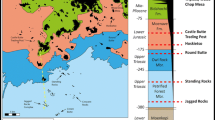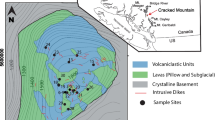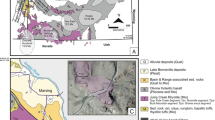Abstract
It is likely that the structure of a volcanic edifice can be significantly modified by deformation caused by large, shallow intrusions. Such deformation may interact with that caused by volcano loading. We explore such intrusion-related and loading-related deformation with field evidence and analogue models. To do this we have chosen the eroded Palaeogene Mull volcano (Scotland) that had a major edifice, has well exposed intrusions and significant deformation. There are thin Mesozoic sedimentary rocks forming ductile layers below the volcano, but their thickness is insufficient to allow the gravitational spreading of the volcanic edifice, especially when considering that a thick lava pile covers them. Thus intrusive push may have been the driving force for deformation. The Mull activity migrated toward the northwest, forming three successive intrusive complexes (Centres 1, 2 and 3). Our detailed fieldwork reveals that deformation due to these was accommodated on three levels; along thrust planes in lava sequences, along a décollement located in a thin clay-rich sediment succession and in basement schists. A relative chronology has been established between different groups of structures using dyke and sill cross-cutting relationships. Centre 1 is surrounded by a fold and thrust belt leading to radial expansion. In contrast, Centre 2 and 3 are connected to thrusts located to the south and east, bounded by strike-slip faults, leading to expansion to the southeast. The migration of centres and the directed sliding of the edifice may be related to the presence to the southeast of low-resistance Dalradian basement that failed significantly during growth of Centres 2 and 3. To study the observed relationships we have carried out scaled analogue models. Models are made with fine powder intruded by a viscous magma analogue. The models show an intimate relationship between intrusion growth, uplift of the volcano and subsequent flank sliding. The structures produced can be compared with Mull and suggest that the Centre 1 thrust belt probably formed following edifice gravitational sliding as a consequence of the uplift associated with Centre 1 formation. Centre 2 and 3 are responsible for the sector sliding of the edifice flank toward the southeast as the magmatic complex became more asymmetric. The features observed at Mull and in the models are similar to those seen on active volcanoes, such as Etna, providing a structural framework for their deformation and evolution.











Similar content being viewed by others
References
Anderson DL, Natland JH (2005) A brief history of the plume hypothesis and its competitors; concept and controversy. Geol Soc Am Special Paper 388:119–145
Bailey EB, Clough CT, Wright WB, Richey JE, Wilson GV (1924) Tertiary and post-tertiary geology of Mull, Loch Aline and Oban. Mem Geol Surv Great Brit 44:172–184
Bailey EB (1962) Early tertiary fold movements in Mull. Geol Mag 99:478–479
Boudon G, Semet MP, Vincent PM (1992) Les éruptions à écroulement de flanc sur le volcan de la Grande Découverte (la Soufriére) de Guadeloupe: implications sur le risque volcanique. Bull Soc Géol Fr 163:159–167
Chambers LM, Pringle MS (2001) Age and duration of activity at the Isle of Mull tertiary igneous centre, Scotland, and confirmation of the existence of subchrons during anomaly 26r. EPSL 193:333–345
Cheeney RF (1962) Early tertiary fold movements in Mull. Geol Mag 99:227–232
Chester DK, Ducan AM, Guest JE, Kilburn CRJ (1985) Mount Etna, the anatomy of a volcano. University press, Cambridge
Donnadieu F, Merle O (1998) Experiments on the indentation process during cryptodome intrusions: new insights into Mount St. Helens deformation. Geol 26(1):79–82
Emeleus CH, Bell BR (2005) British regional geology: the Palaeogene volcanic districts of Scotland, 4th edn. British Geological Survey, Nottingham
Galland O, Cobbold PR, Hallot E, de Bremond d’Ars J, Delavaud G (2006) Use of vegetable oil and silica powder for scale modelling of magmatic intrusion in a deforming brittle crust. EPSL 243:786–804
Hamilton MA, Pearson DG, Thompson RN, Kelley SP, Emeleus CH (1998) Rapid eruption of Skye lavas inferred from precise U-Pb and Ar-Ar dating of the Rum and Cuillin plutonic complexes. Nature 394:260–263
Holohan EP, van Wyk de Vries B, Troll VR (2007) Analogue models of caldera collapse in strike-slip tectonic regimes. doi: 10.1007/s00445-007-0166-x
Jolly RJH, Sanderson DJ (1995) Variation in the form and distribution of dykes in the Mull swarm, Scotland. J Struct Geol 17:1543–1557
Judd JW (1878) The secondary rocks of Scotland. Third paper. The strata of the Western Coast and islands. Quarterly J Geol Soc Lond 34:660–743
Kennedy WQ (1946) The Great Glen Fault. J Geol Soc Lond 102(1–4):41–76
Kerr AC, Kent RW, Thomson BA, Seedhouse JK, Donaldson CH (1999) Geochemical evolution of the tertiary Mull volcano, Western Scotland. J Petrol 40:873–908
Mathieu L, van Wyk de Vries B, Holohan EP, Troll VR (2008) Dykes, cups, saucers and sills: Analogue experiments on magma intrusion into brittle rocks. EPSL 271(1–4):1–13
Merle O, Borgia A (1996) Scaled experiments of volcanic spreading. J Geophys Res 101(B6):13,805–13,817
Merle O, Vendeville B (1994) Experimental modeling of thin-skinned shortening around magmatic intrusions. Bull Volc 57:33–43
Morgan WJ (1971) Convection plumes in the lower mantle. Nature 230:42–43
Oehler JF, Labazuy P, Lénat JF (2004) Recurrence of major flank landslides during the last 2-Ma-history of Reunion Island. Bull Volcanol 66:585–598. doi:10.1007/s0044500403412R
Rast N, Diggens JN, Rast DE (1967) Triassic rocks of the Isle of Mull; their sedimentation, facies, structure, and relationship to the Great Glen Fault and the Mull caldera. Proc Geol Soc Lond 164(5):299–304
Roger DA, Marshall JEA, Astin TR (1989) Devonian and later movements on the Great Glen Fault system. J Geol Soc Lond 146(3):369–372
Saunders AD, Fitton JG, Kerr AC, Norry MJ, Kent RW (1997) The North Atlantic igneous province. In: Mahoney JJ, Coffin ML (eds) Large Igneous Provinces. AGU Geophysical Monograph 100, American Geophysical Union, Washington DC, pp 45–93
Sloan T (1971) The structure of the Mull Tertiary dyke swarm. PhD Thesis, University of London
Sparks RSJ (1988) Petrology of the Loch Ba ring dyke, Mull (NW Scotland): an example of the extreme differentiation of tholeiitic magmas. Contrib Mineral Petrol 100:446–461
Stewart M, Strachan RA, Holdsworth RE (1997) Direct field evidence for sinistral displacements along the Great Glen Fault Zone: late Caledonian reactivation of a regional basement structure? J Geol Soc Lond 154(1):135–139
Van Bemmelen RW (1937) The cause and mechanism of igneous intrusion: with some Scottish examples. Trans Geol Soc Glasg 19:453–492
van Wyk de Vries B, Francis PW (1997) Catastrophic collapse at stratovolcanoes induced by gradual volcano spreading. Nature 387:387–390
Walker GPL (1971) The distribution of amygdale minerals in Mull and Morven (western Scotland). In: Murty TVV, Rao SS (eds) Studies in Earth sciences: a volume in honour of William Dixon West. pp. 182–194
Walker GPL (1975) A new concept in the evolution of the British tertiary intrusive centers. J Geol Soc Lond 131:121–142
Walker GPL, Skelhorn RR (1966) Some associations of acid and basic intrusions. Earth Sci Rev 2:93–109
Acknowledgements
The authors would like to thank the Mull inhabitants, especially G. and J. Kidd and the Corbett brothers, for their help and support during our fieldwork in Scotland. The authors also wish to address a special thank to Tate and Lyle for providing the Golden Syrup that has been invaluable in the lab and has helped diversify the French cuisine.
Author information
Authors and Affiliations
Corresponding author
Additional information
Editorial responsibility H. Delgado Granados
Rights and permissions
About this article
Cite this article
Mathieu, L., Vries, B. Edifice and substrata deformation induced by intrusive complexes and gravitational loading in the Mull volcano (Scotland). Bull Volcanol 71, 1133–1148 (2009). https://doi.org/10.1007/s00445-009-0295-5
Received:
Accepted:
Published:
Issue Date:
DOI: https://doi.org/10.1007/s00445-009-0295-5




